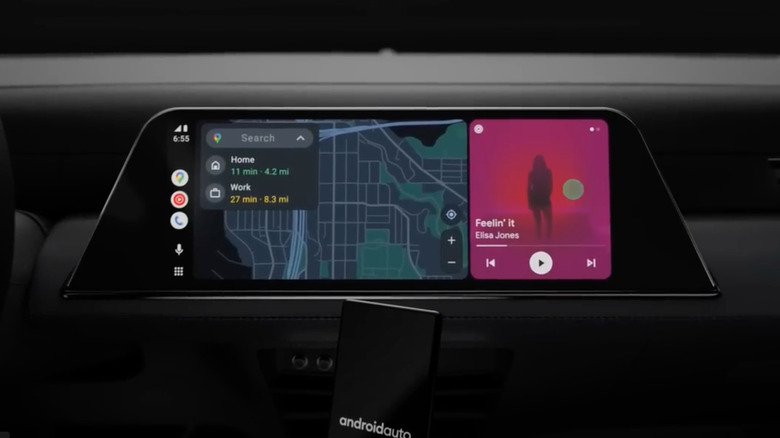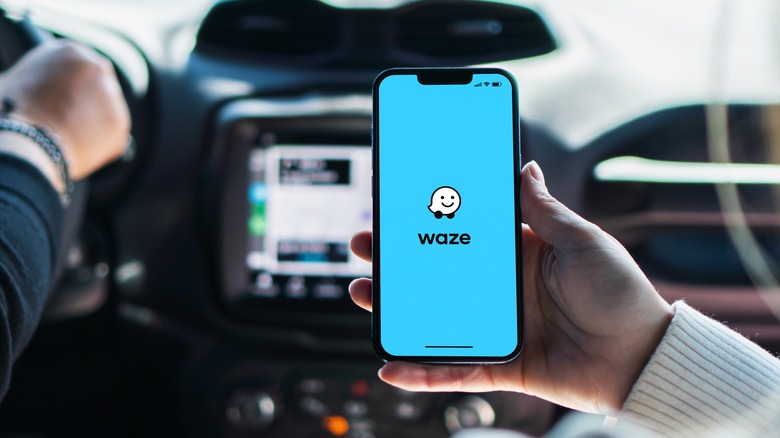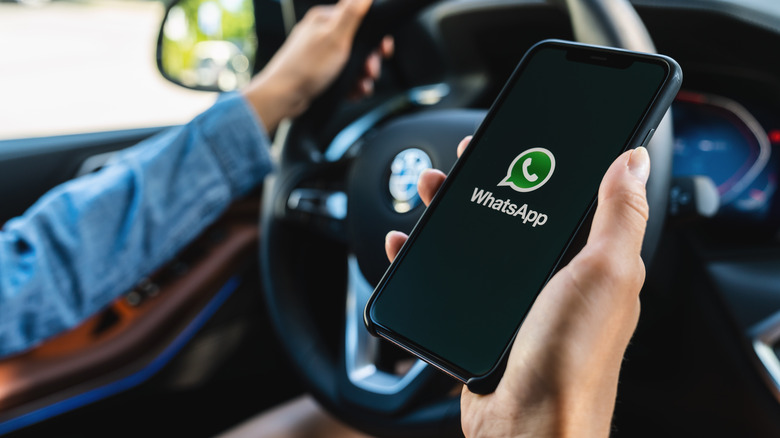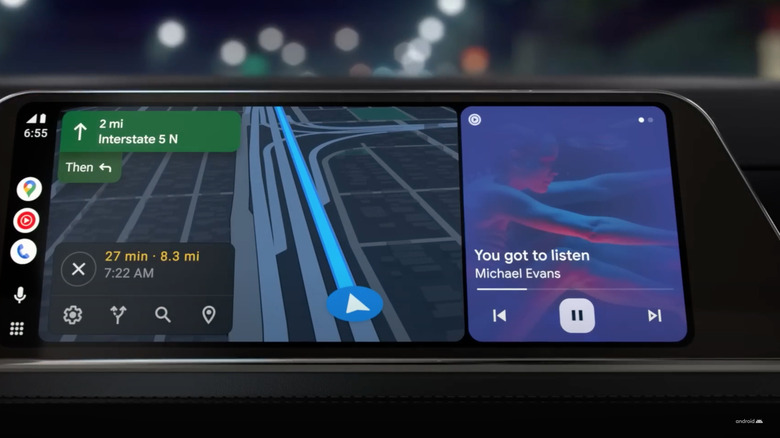3 Features That Will Change The Way You Use Android Auto
Following a multi-year redesign, Google recently rolled out its latest Android Auto UI, codenamed Coolwalk, at CES 2023 in Las Vegas. What's immediately noticeable is that the automotive interface for Android smartphones is sporting a new flexible layout.
Maps is now relocated to a prominent screen position on the drivers side of the vehicle for easier viewing. On the right side of the screen, at least in countries with left-hand drive vehicles, is another tile that typically displays the currently-playing audio source with associated artwork.
A goal of the Android Auto update was to display more information on a single screen without needing to browse the app menu. To that end, when an incoming message is received or Google Assistant makes a suggestion, the non-Maps side of the split screen automatically reduces the size of the "now playing" tile to display the new notification.
But not just a pretty face, the latest revamp has also assigned Google Assistant a larger role. The company says that Google Assistant will now offer proactive suggestions to drivers including returning missed calls, sharing arrival times, and faster, more intuitive access to music or podcasts.
So far, we've focused on aesthetic improvements to mostly existing capabilities, but there were a more substantive features snuck into the Android Auto overhaul, too.
Improved integration for Waze
Besides Maps, Google's other hugely popular navigation app is Waze, which the company purchased back in 2013 for $1.3 billion, outbidding Apple and Facebook in the process. Waze users often sing the praises of the app which utilizes real-time data from other drivers to calculate the fastest routes and accurate ETAs to destinations, taking into consideration delays such as accidents, construction, and even warning of speed traps.
But in spite of being owned by Google, Waze has continually struggled with bugs, freezes, and limited functionality when displayed on Android Auto. The Coolwalk update will right those wrongs by fully integrating Waze, including the ability to display the app on the large navigation tile closest to the driver — placement that was previously reserved only for Google Maps — while other apps run on the split screen.
Waze support for Android Auto's new Coolwalk dashboard has thus far only been available for Beta users, but a widespread rollout is expected to be complete by the end of 2023. In the meantime, Waze will continue to occupy the entire screen, just as it did prior to Coolwalk.
Make calls with WhatsApp
In the past, drivers could only make traditional voice calls via Android Auto. But with the latest update, they can now make VoIP calls using the popular messaging app WhatsApp. Perhaps the most promising facet of this development is if the WhatsApp trial balloon is successful, Google could bring the capability to make and receive VoIP calls within Android Auto to other communication apps.
Additionally, Android Auto is now able to interface with WhatsApp to read incoming messages, send a reply, or create new messages using Google Assistant. Though according to autoevolution, the new technology is experiencing some teething problems.
While the ability to make VoIP calls from Android Auto is an exciting development, please do remember that having a telephone conversation while driving can be a significant cognitive distraction, even if the call is completely hands-free. The National Safety Council found that while a driver involved in a phone conversation may be watching the road, they only notice about 50% of the driving environment versus a driver who's not on the phone. In short, do make calls sparingly for safety's sake.
A seekable progress bar for audio
Many Android Auto users have been vocal in requesting a progress bar and now, their wish is being granted. For drivers who enjoy listening to podcasts or audiobooks on long trips, it can be difficult to resume listening in the right place following a pause. Or perhaps you just want to repeat a favorite part of a song?
The previous version of Android Auto was limited to restarting an audio track from the beginning or skipping to the next one. The only workaround to jump to a position in the middle of a track required fumbling with your connected smartphone to manipulate the progress bar, which, needless to say, is extremely dangerous while operating a moving vehicle.
But lo and behold, a new linear progress bar will be displayed in all Android Auto-compatible music playback apps. The rollout doesn't appear to be instantaneous, however, with some music apps receiving the functionality before others. Nonetheless, the eventual addition of a seek bar for most music apps places Android Auto at an advantage over Apple CarPlay, which largely lacks this technology.



